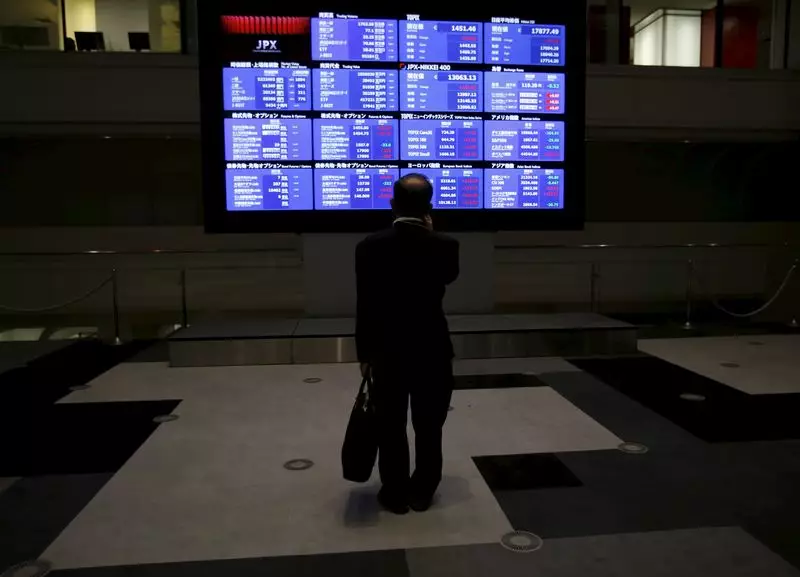As Asian markets opened for trading on a predominantly quiet Monday, investor sentiment remained fragile. With many traders opting for the sidelines due to the holiday season, there was a palpable sense of uncertainty regarding the potential impact of the Chinese government’s recent economic stimulus declarations. Although Finance Minister Lan Foan’s announcement to “significantly increase” national debt was a bold promise, the vagueness surrounding the specific details of these stimulus measures caused some hesitation among investors. The response to this announcement was closely monitored, particularly as the Chinese stock market had surged following aggressive fiscal interventions proclaimed last month.
The crux of the matter lies in the market’s yearning for explicit details about the stimulus package. Investors, after building momentum in anticipation of a clear fiscal direction over the weekend, were left disappointed by a lack of substantive information. Ray Attrill, the head of FX strategy at National Australia Bank, voiced concerns about how this uncertainty could fuel market reactions, particularly as many were anticipating a more decisive fiscal stimulus announcement during the Ministry of Finance briefing. The critical question remains: how much would the stimulus ultimately entail, and how directly would it benefit consumers?
The MSCI index tracking Asia-Pacific shares (excluding Japan) registered a modest increase of 0.12% in early trading—an indication of tepid investor response following a dismal prior week when the index dropped by 1.7%. Anticipations were running high as markets are currently in a state of flux, contending with not only Chinese economic policies but also global trends. Trading volume was significantly reduced, influenced by the Japanese market being closed for a national holiday.
The backdrop of this uncertainty has equally affected U.S. stock futures, which showed slight declines, with S&P 500 and Nasdaq futures down marginally. European indices similarly displayed a lack of momentum as Euro Stoxx 50 and FTSE futures eased by 0.1%. This delicate equilibrium of investor cautiousness paints a broader picture of market dynamics—the ripple effects of China’s unclear fiscal strategies can have significant ramifications for the global economy.
Recent macroeconomic indicators are unsettling, as illustrated by China’s unexpected softening in consumer inflation juxtaposed with exacerbated producer price deflation. Such figures, released over the weekend, are likely to intensify calls for additional stimulus packages, further complicating the investment landscape. The offshore yuan’s slight decline against the U.S. dollar signified investor trepidation as it traded at 7.0842 per dollar, reflecting a potential reaction to the lack of clarity in fiscal assistance. Along similar lines, the Australian dollar, often viewed as a barometer for the onshore yuan, also mirrored this anxiety with a reduced valuation.
Yet, amidst this caution, analysts at Goldman Sachs adjusted their projections for China’s gross domestic product (GDP), raising expectations from 4.7% to 4.9% this year. This upbeat revision underscores a recognition of the potential long-term stabilization offered by the government’s more robust stimulus approach. However, the prevailing structural challenges—characterized by deteriorating demographics, persistent debt issues, and the global shift away from Chinese supply chains—remain significant obstacles that cannot be underestimated.
Currency movements during this turbulent market phase displayed a sense of restraint, with the U.S. dollar maintaining its strength amid diminished expectations for significant Federal Reserve rate cuts in the coming months. The British pound and euro witnessed minor declines as investors digested recent data indicating a slight uptick in consumer prices in the U.S. last month along with overall job market resilience.
In the commodities sector, market reactions were similarly adverse, with oil prices dropping by over $1 a barrel, fuelled by frail inflation reports and nebulous Chinese stimulus plans prompting concerns regarding future demand. Brent crude futures indicated a 1.39% decline, while U.S. West Texas Intermediate prices fell by about 1.4%. Meanwhile, gold prices experienced a slight reduction, reflecting a persistent trend of cautious sentiment among investors navigating through unconventional market conditions.
Ultimately, the ongoing narrative in Asian markets continues to be shaped by these multifaceted factors—an unclear fiscal future in China, rising macroeconomic pressures, and fluctuating sentiments in currency and commodities. As investors remain on edge, the investment community will be looking for clearer signals to determine the trajectory of markets in the weeks to come.

